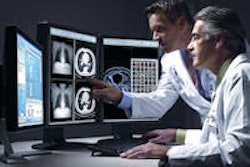
CHICAGO - The child has lower right abdominal pain, and a resident suspects appendicitis. But she wants to make sure.
Yep, there's an app for that.
Researchers said that CT scan images sent via iPhone technology with off-the-shelf, $19.99 software are precise enough for correct diagnoses to be made in 124 of 125 trials of the procedure.
In a study presented at the RSNA 2009 annual meeting, researchers took the charts of 25 patients suspected of having appendicitis and sent them via iPhone (Apple) to five residents and asked the residents to determine a diagnosis on what they could see on their phones.
Only one reader failed to make the right diagnosis. In every other case, the readers determined that 15 of the patients were suffering from appendicitis and 10 of the patients did not have appendicitis and did not require treatment.
 |
| Dr. Asim Choudhri, a fellow in neuroradiology at Johns Hopkins University in Baltimore. |
Choudhri said an 80-image scan can be received in one to five minutes on an iPhone depending on the time of connection -- 3G or WiFi -- that is available. He envisioned that confirmative or suggestive diagnoses could be made by a distant reader in case where onsite hospital staff may seek second opinions.
He noted that about 5% of patients who now present with appendicitislike symptoms go to surgery for normal anatomy. The use of CT technology has reduced the unnecessary surgery from 20% of cases with abdominal pain to 5%. In his study, one of the 10 patients who did not have appendicitis underwent surgery.
The researchers compared the results from the resident readers with those obtained by two gastrointestinal specialists who reviewed the images at a hospital workstation with normal-sized imaging. The two specialists identified all those with appendicitis and all those without appendicitis. Their findings were considered the "gold standard" for comparisons in the study. The results were also double-checked with surgical and medical outcomes.
 |
| Dr. Joseph Tashjian, president of St. Paul Radiology in Minnesota. |
Choudhri used OsiriX mobile software for the iPhone, which allows transmission of medical imaging data though an iTunes application. He said he has no financial involvement with the company.
The use of OsiriX for diagnosing appendicitis is not approved by the U.S. Food and Drug Administration (FDA). Choudhri said he would not recommend that final diagnosis of a patient be considered using the iPhone technology -- rather, that the device be used to guide further diagnostic modalities.
By Ed Susman
AuntMinnie.com contributing writer
December 2, 2009
Related Reading
Medical apps on iPhone demonstrate value, potential, November 30, 2009
Handheld devices show promise for patient education, June 8, 2009
Smartphone vs. PACS: Smartphone does just fine for skeletal trauma, December 4, 2008
PDAs may be suitable for viewing trauma head CT, January 25, 2008
Consumer displays compare well with medical-grade displays, November 27, 2007
Copyright © 2009 AuntMinnie.com



















